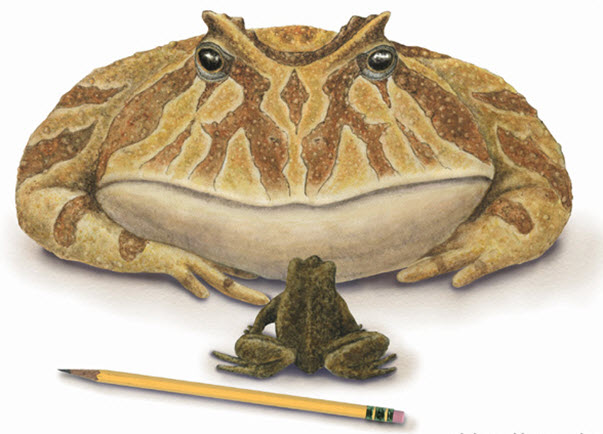Beelzebufo: The Frog from Hell
Posted on February 18, 2008

A team of researchers from the UK's University College London (UCL) and New York's Stony Brook University have discovered the 70 million-year-old fossil of a massive dinosaur-eating frog in Madagascar. The artist's image above shows how the frog would have dwarfed a modern-sized frog. The scientists have named the frog Beelzebufo, meaning "the frog from hell." The full name is Beelzebufo ampinga and its nickname is devil frog.
The frog weighed 4kg and had a body length of up to 40cm. It also had a squat body, huge head and wide mouth. Professor Susan Evans, UCL Anatomy & Developmental Biology, said the frog would have been the size of a squashed beach-ball. She also says the frog may have been large enough to consume small dinosaurs.
Evans said, "This frog, a relative of today's Horned toads, would have been the size of a slightly squashed beach-ball, with short legs and a big mouth. If it shared the aggressive temperament and 'sit-and-wait' ambush tactics of living Horned toads, it would have been a formidable predator on small animals. Its diet would most likely have consisted of insects and small vertebrates like lizards, but it's not impossible that Beelzebufo might even have munched on hatchling or juvenile dinosaurs."
Beelzebufo Quick Facts
- Weighed about 4 kg (8.8 lbs)
- 41 centimeters tall (16 inches)
- Horns on its head above its eyes
- Ate insects, lizards and other small animals, possible small dinosaurs and baby dinosaurs
- May have had an ambush style pounce attack
- Very aggressive temperament like other ceratophyrines, its modern day relatives
- Likely had powerful jaws and large mouth like modern day South American horn frogs (aka Pac-Man frogs)
- Armor-like plating on its skull and back
- Resided in Madagascar during the Late Cretaceous period
The find is also interesting because it sheds new light on a debate about how the earth's land masses used to be arranged. The frog find gives credence to a theory that Madagascar was once linked to India and South America.
Professor Evans said, "Our discovery of a frog strikingly different from today's Madagascan frogs, and akin to the Horned toads previously considered endemic to South America, lends weight to the controversial paleobiogeographical model suggesting that Madagascar, the Indian subcontinent and South America were linked well into the Late Cretaceous. It also suggests that the initial spread of such beasts began earlier than that proposed by recent estimates."
A research paper on the giant frog can be found in the Proceedings of the National Academy of Science.
Armored Head and BackMore recently, scientists have discovered that the "devil frog" also had plate-like armor on its skull and down its back to protect it from large predators. The frog also would have been hard to kill in addition to being a major predator of any creatures that were smaller than the huge frog. The armor may have also helped the frog burrow underground.
Bite Force StudyA 2017 study published in Scientific Reports examined the bite force of the beelzebufo. It found that it may have had a bite force of up to 2200 N based on the bite force of modern horn frogs. The researchers say, "Aggressive and able to consume vertebrates their own size, these 'hopping heads' use a vice-like grip of their jaws to restrain and immobilize prey."
Dr. Marc Jones, researcher at the University of Adelaide’s School of Biological Sciences and honorary researcher at the South Australian Museum, says, "At this bite force, Beelzebufo would have been capable of subduing the small and juvenile dinosaurs that shared its environment."
Updated: 6-13-19
Image: SUNY-Stony Brook
